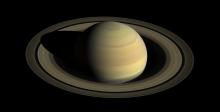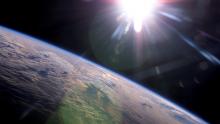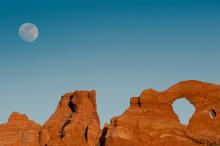Listen to today's episode of StarDate on the web the same day it airs in high-quality streaming audio without any extra ads or announcements. Choose a $8 one-month pass, or listen every day for a year for just $30.
You are here
Summer Moon
There’s a lot to talk about on this first day of summer. For one thing ... well, it’s the first day of summer! And for another, the worlds that pass closest to Earth form a tight triangle in the evening sky.
Summer arrives at 9:58 a.m. Central Time — the moment of the June solstice. For the northern hemisphere, the Sun stands highest in the sky for the entire year. And the solstice is the longest day of the year, so there’s more time to enjoy our high-climbing star.
After the solstice, the days start to get shorter, but not by much. It takes a while for the difference to add up to enough for us to notice.
At the same time, the Sun’s high point begins to creep southward — and so do its rising and setting points. Again, it’s a slow process at first, so it takes a few days or even weeks to notice the difference. In fact, the word “solstice” means “Sun stands still” — a reference to the barely noticeable change in the Sun’s position from day to day.
It’s a lot easier to see changes in the position of the Moon. Tonight, it’s quite close to Venus, the “evening star.” Fainter Mars is close to the upper left of the brilliant duo.
Venus and Mars pass closer to us than any other planets. Of all the major bodies in the solar system, only the Moon is closer.
By tomorrow night, the Moon will have moved away from Venus and Mars, and will be close to Regulus, the heart of the lion. More about that tomorrow.
Script by Damond Benningfield






